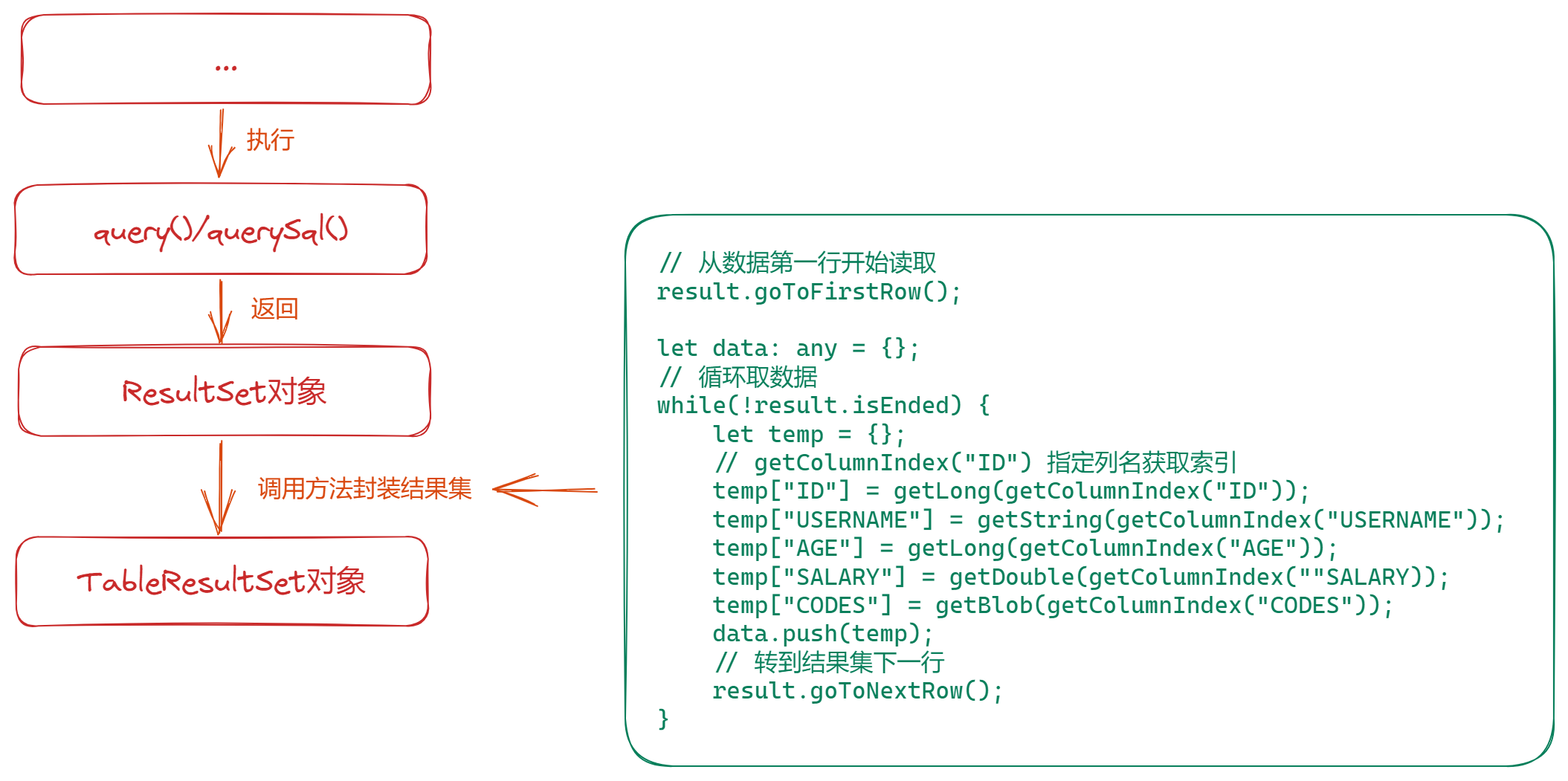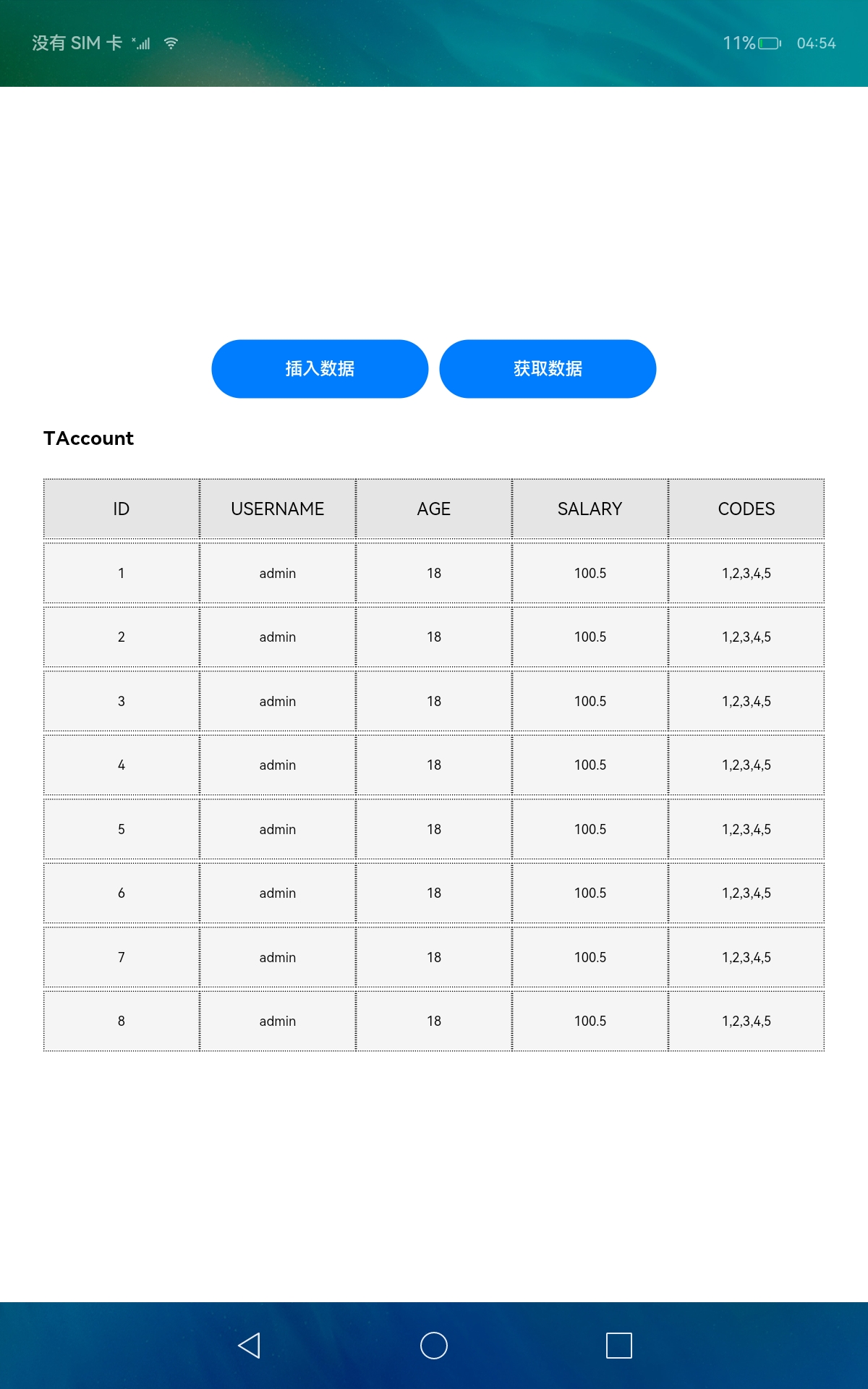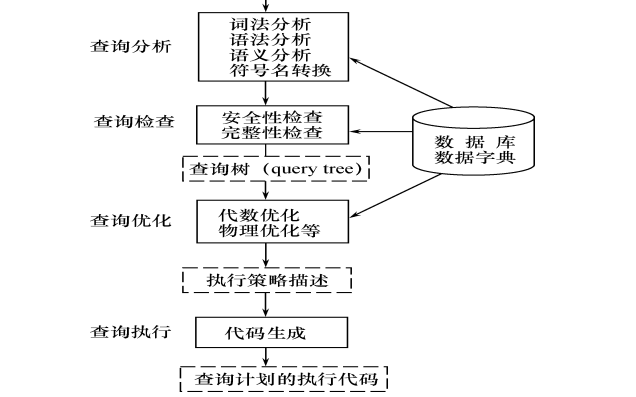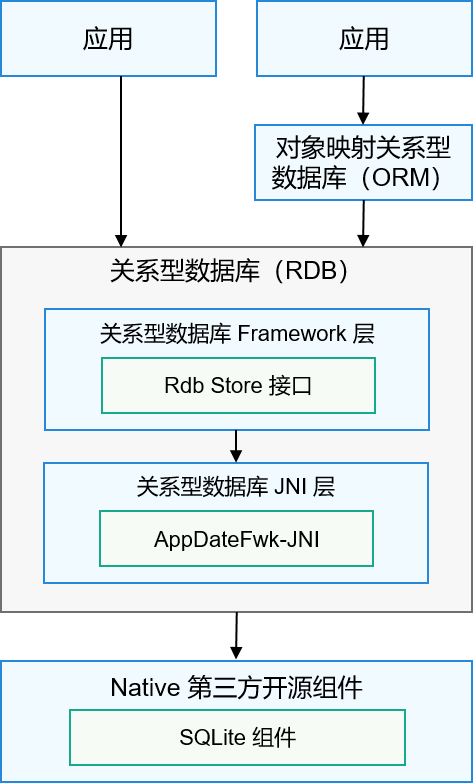1 ResultSet(結果集)
ResultSet(結果集)是OpenHarmony關系型數據庫提供查詢數據表返回結果的方法,提供了多種靈活的數據訪問方式,以便于開發者獲取各項數據,ResultSet屬性如表1-1所示,ResultSet方法如表1-2所示。
表1-1 ResultSet屬性
| 名稱 | 類型 | 必填 | 說明 |
|---|---|---|---|
| columnNames | Array | 是 | 結果集中所有列的名稱 |
| columnCount | number | 是 | 結果集中的列數 |
| rowCount | number | 是 | 結果集中的行數 |
| rowIndex | number | 是 | 結果集當前行的索引 |
| isAtFirstRow | boolean | 是 | 結果集是否位于第一行 |
| isAtLastRow | boolean | 是 | 結果集是否位于最后一行 |
| isEnded | boolean | 是 | 結果集是否位于最后一行之后 |
| isStarted | boolean | 是 | 指針是否移動過 |
| isClosed | boolean | 是 | 當前結果集是否關閉 |
表1-2 ResultSet方法
| 名稱 | 描述 |
|---|---|
| getColumnIndex(columnName: string): number | 根據指定的列名獲取列索引columnName: 結果集中指定列的名稱 number: 返回指定列的索引 |
| getColumnName(columnIndex: number): string | 根據指定的列索引獲取列名columnIndex: 結果集中指定列的索引string: 返回指定列的名稱 |
| goTo(offset: number): boolean | 向前或向后轉至結果集的指定行,相對于當前行位置偏移offset: 表示相對于當前行位置偏移量boolean:操作成功,則為true,否則為false |
| goToRow(position: number): boolean | 轉到結果集的指定行position: 表示要移動到的指定位置boolean: 操作成功,則為true,否則為false |
| goToFirstRow(): boolean | 轉到結果集的第一行boolean: 操作成功,則為true,否則為false |
| goToLastRow(): boolean | 轉到結果集的最后一行boolean: 操作成功,則為true,否則為false |
| goToNextRow(): boolean | 轉到結果集的下一行boolean: 操作成功,則為true,否則為false |
| goToPreviousRow(): boolean | 轉到結果集上一行boolean: 操作成功,則為true,否則為false |
| getBlob(columnIndex: number): Uint8Array | 以字節數組的形式獲取當前行中指定列的值指定的列索引,從0開始Uint8Array: 以字節數組的形式返回指定列的值 |
| getString(columnIndex: number): string | 以字符串形式獲取當前行中指定列的值columnIndex: 指定的列索引,從0開始string: 以字符串形式返回指定列的值 |
| getLong(columnIndex: number): number | 以Long形式獲取當前行中指定列的值columnIndex: 指定的列索引,從0開始number: 以Long形式返回指定列的值。該接口支持的數據范圍是:Number.MIN_SAFE_INTEGER~Number.MAX_SAFE_INTEGER,若超出該范圍,則建議使用getDouble |
| getDouble(columnIndex: number): number | 以double形式獲取當前行中指定列的值columnIndex: 指定的列索引,從0開始number: 以double形式返回指定列的值 |
| isColumnNull(columnIndex: number): boolean | 檢查當前行中指定列的值是否為nullcolumnIndex: 指定的列索引,從0開始boolean: 當前行中指定列的值為null,則返回true,否則為false |
| close(): void | 關閉結果集 |
2 流程

3 步驟
3.1 獲取ResultSet結果集
通過RdbStore實例的query()或querySql()方法獲得ResultSet結果集。
let predicates = new relationalStore.RdbPredicates(this.tableName);
let result = await this.rdbStore.query(predicates, columns);
3.2 自定義返回結果類
自定義TableResultSet類用于前臺展示。
export class TableResultSet {
private total: number; // 總條數
private data: any; // 數據表數據
setTotal(total: number) {
this.total = total;
}
setData(data: any) {
this.data = data;
}
}
3.3 結果集轉返回結果
ResultSet并不能直接用來展示,通過ResultSet提供的各類方法獲取需要的信息。
private resultToObject(result: relationalStore.ResultSet) {
let trs = new TableResultSet();
trs.setData(result.rowCount);
let data: Array<any> = [];
let count = result.rowCount;
if (count === 0 || typeof count === 'string') {
trs.setData([]);
} else {
// 從數據第一行開始讀取
result.goToFirstRow();
for (let j = 0; j < count; j++) {
let temp: any = {};
for (let i = 0; i < this.fields.length; i++) {
let field = this.fields[i];
if (field.type === 'INTEGER' || field.type === 'integer') {
temp[field.name] = result.getLong(result.getColumnIndex(field.name));
} else if (field.type === 'REAL' || field.type === 'real') {
temp[field.name] = result.getDouble(result.getColumnIndex(field.name));
} else if (field.type === 'TEXT' || field.type === 'text') {
temp[field.name] = result.getString(result.getColumnIndex(field.name));
} else if (field.type === 'BLOB' || field.type === 'blob') {
temp[field.name] = result.getBlob(result.getColumnIndex(field.name));
}
}
data.push(temp);
result.goToNextRow();
}
trs.setData(data);
}
return trs;
}
4 呈現結果
- 使用斷點調試方式

- 使用日志調試方式
Log.info(TAG, `Query of ${this.tableName} table data succeeded. data: ` + JSON.stringify(result));

- 頁面顯示
// 顯示表名稱
Text(TableConstants.T_ACCOUNT_NAME)
.fontSize(18)
.fontWeight(700)
.width('90%').height(54)
Column({space: 5}) {
if (this.result !== null) {
// 顯示表字段
GridRow({
columns: TableConstants.T_ACCOUNT_FIELDS.length,
direction: GridRowDirection.Row
}) {
ForEach(this.result.fields, (field) => {
GridCol() {
Text(field)
.width("100%").height(54)
.fontSize(16)
.textAlign(TextAlign.Center)
}
.colStyle()
})
}
.width('90%').height(54)
.backgroundColor(0xE5E5E5)
// 顯示表數據
ForEach(this.result.data, (item) => {
GridRow({
columns: TableConstants.T_ACCOUNT_FIELDS.length,
direction: GridRowDirection.Row
}) {
ForEach(TableConstants.T_ACCOUNT_FIELDS, (field) => {
GridCol() {
this.Label(item[field.name].toString())
}
.colStyle()
})
}
.width('90%').height(54)
.backgroundColor(0xF5F5F5)
}, temp => temp.toString())
}
}
.width('100%')

聲明:本文內容及配圖由入駐作者撰寫或者入駐合作網站授權轉載。文章觀點僅代表作者本人,不代表電子發燒友網立場。文章及其配圖僅供工程師學習之用,如有內容侵權或者其他違規問題,請聯系本站處理。
舉報投訴
-
數據庫
+關注
關注
7文章
3922瀏覽量
66149 -
關系型數據庫
+關注
關注
0文章
8瀏覽量
2403 -
OpenHarmony
+關注
關注
29文章
3848瀏覽量
18534
發布評論請先 登錄
相關推薦
熱點推薦
HarmonyOS關系型數據庫和對象關系數據庫的使用方法
容易就上手的知識。本篇速成教程直接使用最精準和簡短的文字,再配上講解代碼,讓我們能在10分鐘左右就能掌握最基本的數據庫使用方法。數據庫的三大要素:數據庫、表、字段,接下來為大家介紹關系
發表于 03-29 14:10
基于數據庫查詢過程優化設計
在大型關系數據庫管理與開發中,優化設計極大地提高數據庫的性能。通過對一大型數據庫查詢語句執行過程的討論,提出了對同一表格進行多個選擇運算的優
發表于 02-27 16:05
?18次下載
hbase和關系型數據庫的區別
hbase和關系型數據庫的區別就是對于傳統數據庫,增加列對于一個項目來講,改變是非常大的。但是對于nosql,插入列和刪除列,跟傳統數據庫里
發表于 12-27 15:51
?1.2w次閱讀

數據庫系統概論之如何進行關系查詢處理和查詢優化
本文檔的主要內容詳細介紹的是數據庫系統概論之如何進行關系查詢處理和查詢優化主要內容包括了:1、關系數據庫系統的
發表于 11-15 15:12
?11次下載

關系型數據庫的基本原理(什么是關系型數據庫)
組成。關系數據庫是基于實用和可重復使用的概念,是支持高性能交互查詢、交易處理能力、安全性和靈活性的關鍵數據存儲和維護方法。關系型
python讀取數據庫數據 python查詢數據庫 python數據庫連接
python讀取數據庫數據 python查詢數據庫 python數據庫連接 Python是一門高級編程語言,廣泛應用于各種領域。其中,Pyt





 OpenHarmony關系型數據庫查詢結果呈現
OpenHarmony關系型數據庫查詢結果呈現













評論